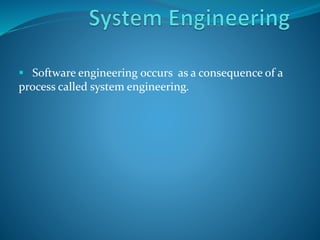
System engineering
- 1. Software engineering occurs as a consequence of a process called system engineering.
- 2. The overall objective of the system must be determined: The role of hardware, software, people, database, procedures, and other system elements must be identified. Operational requirements must be elicited/extracted, analyzed, specified, modeled, validated, and managed. These activities are the foundation of system engineering.
- 3. Business process engineering: The system engineering process is called business process engineering when the context of the engineering work focuses on a business enterprise. Product engineering: When a product is to be built, the process is called product engineering. Both business process engineering and product engineering attempt to bring order to the development of computer-based systems.
- 4. System engineering is a modeling process. To construct a system model, the engineer should consider a number of factors: o Assumptions o Simplifications o Limitations o Constraints o Preferences
- 5. o Assumptions: Reduce the number of possible permutations and variations. o Simplifications: enable the model to be created in a timely manner. o Limitations: Help to bound the system. o Constraints: Will guide the manner in which the model is created and the approach taken when the model is implemented. o Preferences: Indicate the preferred architecture for all data, functions, and technology.
- 6. We define a computer-based system as A set or arrangement of elements that are organized to accomplish some predefined goal by processing information.
- 7. To accomplish the goal, a computer-based system makes use of a variety of system elements. Software: Computer programs, data structures, and related documentation that serve to effect the logical method, procedure, or control that is required. Hardware: Electronic devices that provide computing capability, the interconnectivity devices (e.g., network switches, telecommunications devices) that enable the flow of data, and electromechanical devices (e.g., sensors, motors, pumps) that provide external world function. People: Users and operators of hardware and software.
- 8. Database: A large, organized collection of information that is accessed via software. Documentation: Descriptive information (e.g., hardcopy manuals, on-line help files, Web sites) that represents the use and/or operation of the system. Procedures: The steps that define the specific use of each system element or the procedural context in which the system resides.
- 9. THE SYSTEM ENGINEERING HIERARCHY
- 10. Regardless of its domain of focus, system engineering encompasses a collection of top-down and bottom-up methods to navigate the hierarchy. The system engineering process usually begins with a “world view.” The world view is refined to focus more fully on specific domain of interest. Within a specific domain, the need for targeted system elements (e.g., data, software, hardware, people) is analyzed.
- 11. The world view (WV) is composed of a set of domains (Di), which can each be a system or system of systems in its own right. WV = {D1, D2, D3, . . . , Dn}
- 12. Each domain is composed of specific elements (Ej) each of which serves some role in accomplishing the objective and goals of the domain or component: Di= {E1, E2, E3, . . . , Em} Finally, each element is implemented by specifying the technical components (Ck) that achieve the necessary function for an element: Ej= {C1, C2, C3, . . . , Ck}
- 14. Three different architectures must be analyzed and designed within the context of business objectives and goals: o data architecture o applications architecture o technology infrastructure
- 15. o The data architecture provides a framework for the information needs of a business or business function. o The application architecture encompasses those elements of a system that transform objects within the data architecture for some business purpose.
- 16. o The technology infrastructure provides the foundation for the data and application architectures. The infrastructure encompasses the hardware and software that are used to support the application and data.
- 17. The product engineering hierarchy:
- 18. The goal of product engineering is to translate the customer’s desire for a set of defined capabilities into a working product. To achieve this goal, product engineering—like business process engineering—must derive architecture and infrastructure.
- 19. o The architecture encompasses four distinct system components: software, hardware, data (and databases), and people. o The infrastructure includes the technology required to tie the components together and the information that is used to support the components.
- 20. Like most engineering activities, business process reengineering is iterative. Business goals and the processes that achieve them must be adapted to a changing business environment. For this reason, there is no start and end to BPR—it is an evolutionary process.
- 21. The model defines six activities: 1. Business definition: Business goals are identified within the context of four key drivers: cost reduction, time reduction, quality improvement, and personnel development and empowerment. 2 . Process identification: Processes that defined in the business definition are identified. They may then be ranked by importance that is ssfor the reengineering activity.
- 22. 3. Process evaluation: The existing process is thoroughly analyzed and measured. Process tasks are identified; the costs and time consumed by process tasks are noted; and quality/performance problems are isolated. 4. Process specification and design: Based on information obtained during the first three BPR activities, use-cases that are prepared for each process that is to be redesigned.
- 23. 5. Prototyping: A redesigned business process must be prototyped before it is fully integrated into the business. This activity “tests” the process so that refinements can be made. 6. Refinement and instantiation: Based on feedback from the prototype, the business process is refined and then instantiated within a business system.
- 24. BPR model